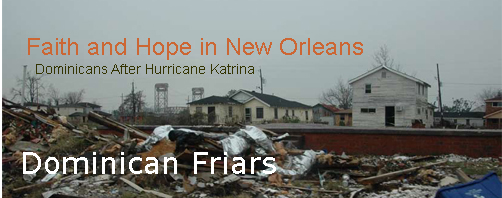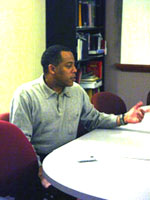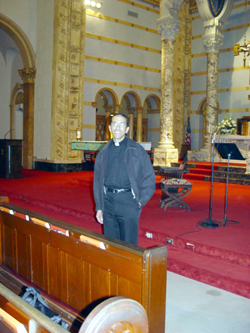
C’est Si Bon: Dominican Friars
Fully Engaged
in Post-Katrina Recovery
 |
Bro.
Herman Johnson, OP |
What is C’est si bon (translation: It’s
so good)? Is it a popular song recorded by Eartha
Kitt? Is it the name of a restaurant on St. Charles
Street? Is it a positive spirit to be found in New Orleans
among those committed to rebuilding a severely damaged
city? The answer is: all of the above.
Signs throughout the city bravely declare, “We’ll
be back.” Meanwhile the presence of Dominican friars
in Louisiana continues as it has since 1911 and now, two
years after Hurricane Katrina and its aftermath of flood,
the men seem truly undaunted by the monumental challenges
that still lie ahead.
The Southern Province has its Provincial
office in Metairie. The building sustained wind damage,
but did not flood. Fr. Emiliano Zapata, OP, Socius and
Vicar Provincial, shared that there are currently 19 friars
living and ministering in the city. They live in two priories
and lead two parishes: St. Anthony of Padua on Canal Street
in Mid-City and St. Dominic in the Lakeview district. The
parish buildings, including the schools, belong to the
Archdiocese of New Orleans, and were woefully underinsured
for the water damage they sustained.
We caught up with Bro. Herman Johnson between classes
at Xavier University, an institution that is Catholic and
historically serves the Black student body. With
its purpose to promote a more just and humane society,
Xavier prepares its students to assume roles of leadership
and service in society.
Bro. Herman, professor of Spanish in the
Modern Languages Department, is a native New Orleanian
who elected to remain in the city and assist his neighbors:
33 sick and elderly people who were trapped in their homes.
As was reported by Claudia McDonnell of Catholic New York
in October 2005, Bro. Herman recalled that “Many
of them were lying in bed when we rescued them. The mattresses
were already floating. After we swam to them, we would
walk in the water, dragging the mattress. We floated them
to our house.”
For a time, Bro. Herman, like so many others, had to learn
to cope without many of the things most of us take for
granted: a clean, safe place to live, a regular job, a
sense of normalcy. “But,” he said, “it’s
helping me to deepen my prayer life, to come to know who
I am as I am, [apart from] the externals that humans use
to define themselves.”
Bro. Herman is thrilled that Xavier University was reopened
as of January 2005 and hopes the school will be able to
regain the students and teachers who were forced to leave
and have not been able to return. “I wanted to return
to continue our 75 plus year tradition of Dominicans at
Xavier.”
“I’m hopeful that we’ll again be a great
city and a great university, but it will take time. The
city was racked with social ills before Katrina. Racism
is a perennial problem in New Orleans. In rebuilding the
city it won’t work to ignore the poor.”
We asked Bro. Herman what he would wish for if guaranteed
that he could be granted three. He told us he prays that
the inner city parishes and schools that were closed will
be reopened, that there will be more assistance for Xavier
University students, 90% of whom rely on financial aid,
and that the priory will be restored so that he can return
there to live with his brothers.
As he left us to administer a test to his class downstairs,
he assured us, “Every day I do see grace to do things
in a new way.”
A trip to St. Dominic Parish meant a sobering ride through
Lakeview which was flooded when several wall panels of
the 17th Street Canal levee failed. What was once a lovely
middle-class neighborhood of 12,500 households now looks
like a war zone. Some lots have been scraped clean, some
homes have been gutted, some are being rebuilt, but many
more stand, badly damaged, rotting and abandoned.
We were fortunate to find Fr. Paul Watkins,
OP, in the trailer being used as the parish office at St.
Dominic, and he generously took time to show us the priory
and the church. “We
had 3,600 families here before Katrina; now we have 1,200,” he
told us. He showed us the windowless second-floor stairwell
where the Prior Provincial, Marty Gleeson, OP and a friar,
Chrys Finn, OP, had taken shelter, set up an altar and
prayed before being rescued by boat.
Fr. Paul smiled as he showed us the work that is being
done to restore the priory where eight to ten feet of water
flooded the first floor. He was still smiling as he outlined
the massive cleanup that had to be done in the church,
and the plans for new lighting and new pews. The parishioners
make do for now with folding metal chairs. It was beginning
to occur to us that smiling is what one does in this phase
of the recovery of New Orleans, because what is the alternative?
If one had any doubt, one only needed to see the children
on the playground at the school to recall that they count
on having their lives rebuilt.
Next we drove across town to St. Anthony Priory, where
we came upon Fr. Charles Latour, OP, busily overseeing
the restoration of the three-story, 80-year-old building. “It’s
a great day,” he told us, “because today the
friars’ mattresses were delivered. No furniture
yet, but the mattresses arrived!” When the
three story building is ready, the 11 friars assigned
to St. Anthony will be able to live in community once again;
for now they meet for evening meals and three friars live
in a rented house nearby.
 |
fr.
Ian Bordenave, OP, pastor |
The pastor, Fr. Ian Bordenave, OP, waved
as he came from one meeting on his way to another and expressed
his regret that he couldn’t stop to chat. While the
school was flooded, the church was not, and only about
60 families have not returned since Katrina.
At the end of the day, we were tired. It wasn’t
that the day had been physically taxing, but because
we had seen and heard so much that expressed fear, confusion,
loss, sadness and frustration. But at the same time, we
had witnessed many signs of hope. The friars of the Southern
Province we met are sincerely energized by the work before
them. In fact, they see it as an opportunity to preach
the Word of faith in God, even in the midst of a massive
and slow recovery from one of this country’s worst
natural disasters.
Story Contributors: Al Judy, OP (St. Albert), Donna
Brunnell, OP (Hope), Kate Martin (San Rafael), Lucy
Sanchez (St. Albert), and Isabelle Williamson (St. Martin)
|

 Can't
open PDF format files? Click on the link to download the latest Adobe
Reader. It is safe and secure and free. Really.
Can't
open PDF format files? Click on the link to download the latest Adobe
Reader. It is safe and secure and free. Really.




